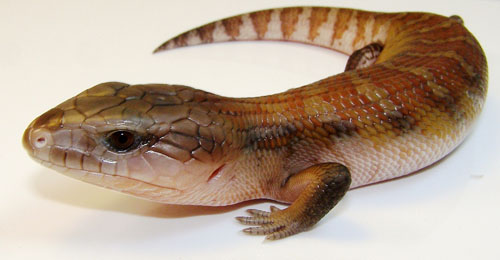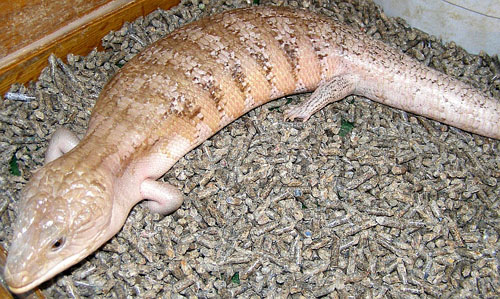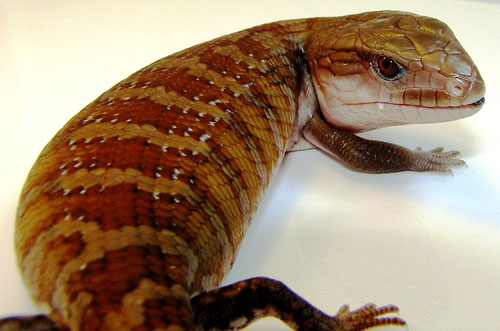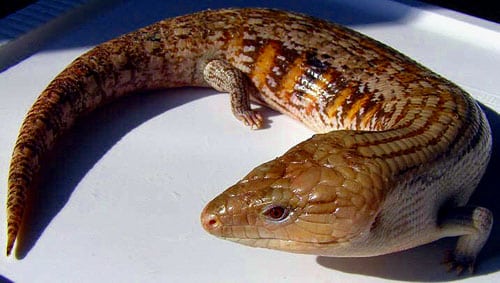Care sheet for the blue-tongued skink (Tiliqua scincoides intermedia).
Updated February 3, 2023
Blue-Tongued Skink (Tiliqua scincoides intermedia)
This care sheet applies specifically to the Northern blue-tongue skink, but most species and subspecies of blue-tongued skinks can be kept using these guidelines. Blue-tongued skinks are ideal for beginners, as they have loads of personality and great dispositions. Blue-tongued skinks are also an excellent choice for advanced hobbyists, as breeding them can be challenging and certain blue-tongue species and localities are extremely rare.
Blue-Tongued Skink Availability
Northern blue-tongued skinks are available seasonally, with most litters dropped June through August. Other species, including Indonesian blue-tongued skinks (Tiliqua gigas gigas), are more readily available and often imported, but Northern blue-tongued skinks are hardier and make better pets. Be sure to choose reptiles from a reputable source and look for active lizards with bright, open eyes. Check for open ear canals, clean toes with no sign of retained shed skin, and observe the overall appearance of the lizard for signs of health. Northern blue-tongued skinks range in price from $150 for babies to $250 for adults. High-colored or rarer forms may cost more. Rare blue-tongued skinks such as centralians and shinglebacks may cost between $1,500 and $5,000 each.
Blue-Tongued Skink Size
The Northern blue-tongued skink is the largest blue-tongue. The total length of an adult usually ranges between 18 and 24 inches.
Blue-Tongued Skink Life Span
Kept properly, blue-tongued skinks can live for 15 to 20 years, and possibly longer.
Blue-Tongued Skink Enclosure
Baby blue-tongues should be housed singly in plastic reptile enclosures, terrariums or 20-gallon aquariums with full screen tops. An adult blue-tongued skink requires, at minimum, an enclosure measuring 4’x’2’x’2, with a full screen top. Larger is even better. Remember, blue-tongued skinks are terrestrial and prefer floor space over climbing area.
All blue-tongued skinks, both juveniles and adults, are best kept singly. You may be able to house females together, or a male and female pair, but observe them very closely. If they fight, keep them in separate cages. Males should never be kept together.

Phil Goss
This 2-week-old baby northern blue-tongued skink can be kept in a 20-gallon terrarium or similarly sized enclosure.
Blue-Tongued Skink Lighting and Temperature
Reptiles control their body temperature through thermoregulation, and it’s crucial for your blue-tongued skink enclosure to have a warm end and a cooler end. Place all heating and lighting at one end of the enclosure, so if your blue-tongue gets too warm, it can move toward the cooler end opposite, and vice versa if it gets too cold. A thermometer at each end to monitor temperatures is recommended.
Blue-tongued skink enclosures should have ambient temperatures on the cool side from 75 to 82 degrees Fahrenheit. The warm end should include a basking area of 90 to 100 degrees. This can be accomplished using an under-tank heating device, such as a heat mat or heat tape, and/or an overhead incandescent basking light or heat emitter. If both under-tank and overhead heat are provided, the overhead heating devices should be turned off at night. Daylight bulbs should be on a maximum of 12 hours each day. The cooler end of the enclosure can drop to 70 degrees at night.
Though there are documented cases of blue-tongues being raised successfully without exposure to full-spectrum lighting, I do recommend UVB lighting in blue-tongued skink enclosures. The UVB lights should be on eight to 12 hours a day. Any UVB bulb will also provide UVA, which is beneficial to blue-tongued skinks.

Phil Goss
This adult northern blue-tongued skink is more lightly colored than usual. .
Blue-Tongued Skink Substrate and Accessories
Aspen, recycled paper substrates, fir bark and cypress mulch (as long as it’s kept dry) can all be used safely with blue-tongued skinks. Cedar chips, clay cat litter, orchid bark and walnut shells should never be used, as these substrates may lead to toxicity, impaction or respiratory concerns. Whichever substrate you choose, be sure your skink does not ingest it. Accidental ingestion can be deterred by using a feeding dish. Blue-tongues spend their time on the ground, so keep the substrate clean and maintained.
Blue-tongues may climb over rocks and logs, but they are not agile climbers. Be sure they cannot fall from any high areas, such as stacked rocks or branches, in their enclosures. Proper housing accessories include cork bark, Mopani wood, logs, large rocks and hide boxes or other shelters. Do not clutter the cage, as blue tongues enjoy plenty of open space. Elaborate decorations are unnecessary and will be rearranged by blue-tongues.

Phil Goss
This young blue-tongue will grow into a personable pet lizard that enjoys having its head and chin scratched.
Blue-Tongued Skink Diet and Feeding
Blue-tongued skinks are extremely hardy lizards that will thrive on just about any diet, but a well-balanced diet will result in a more active, healthier blue-tongued skink.
Blue-tongues are omnivorous and should be fed a combination of proteins, vegetables/greens and fruits. Variety is important. Switch protein sources and provide diversity when feeding canned foods. For each feeding, a ratio of 50 percent vegetables/greens, 40 percent protein and 10 percent fruit is ideal. Adult blue-tongued skinks should be fed every two to three days. Young blue-tongues do best when fed every other day. Feed them as much as they will eat in one sitting. After your skink has stopped eating, uneaten food should be removed immediately.
A quality vitamin/calcium supplement with vitamin D3 is important, especially if you’re not providing a sufficiently varied and well-rounded menu. Sprinkle the supplement over your blue-tongue’s food every third feeding for adults and every other meal for young blue-tongues that are still growing.
Below is a list of menu items that are appropriate for blue-tongued skinks. Feel free to try other types, but avoid citrus, avocado, eggplant, rhubarb and high-sodium canned meats/foods.
Proteins:
Canned super premium dog/cat food
Dry super premium dog/cat food (moistened)
Canned insect products (any variety, but snails are a favorite)
Mealworms and superworms
Hard-boiled eggs
Boiled chicken
Ground turkey (cooked)
Lean ground beef (cooked)
Pinky mice (live or frozen/thawed, but only occasionally)
Fruits and Veggies:
Collard greens
Turnip greens
Mustard greens
Squash (including spaghetti, scallop, butternut, acorn, Hubbard, etc.)
Peas
Brussel sprouts
Carrots
Dandelions (pesticide free)
Hibiscus flowers (pesticide free)
Mango
Raspberries
Figs
Papaya
Cantaloupe
Strawberries
Blueberries
If feeding canned dog/cat foods to your blue-tongued skink, be sure to feed only super premium foods that contain no by-products and no meat/bone meal. Many foods are available with fruits and vegetables included; they are not a substitute for fresh foods, but they are preferred over 100-percent-protein cat/dog foods. Cat foods usually contain twice the protein of dog foods, so if you plan to offer either to your blue-tongues, I recommend dog foods over cat foods. If a skink is emaciated, cat/kitten food will help add weight. Cat food may also be fed to breeding skinks.
Be sure to read the nutrition information on manufactured foods. I recommend avoiding corn-based foods, as well as foods that contain artificial colors, by-products (including chicken by-products) and meat/bone meal, as well as any foods that contain water as the main ingredient.
Blue-Tongued Skink Water and Humidity
Clean water should always be accessible in an appropriate water dish. Blue-tongued skinks are not good swimmers and must be able to easily exit the water bowl. Also be sure the water bowl cannot be easily tipped over. Northern blue-tongues are from semi-dry areas and require low humidity with adequate ventilation. Humidity levels ranging between 40 and 60 percent are ideal for Northern blue-tongues. Indonesian, Tanimbar, Irian Jaya, Merauke and Kei Island blue-tongued skinks may prefer slightly higher humidity levels. Use a hygrometer to monitor humidity levels.
Blue-Tongued Skink Handling and Temperament
Any new reptile, including a new blue-tongued skink, should be allowed to acclimate for a few days. It should not be handled until it is comfortable in its new environment. Once your new blue-tongue is feeding regularly, then handling can begin.
Initial handling sessions should be limited to 10 minutes or less per session. This can be done a couple times each day during the acclimation process. Be sure to hold your blue-tongue close to the floor or over a bed, sofa, etc., in case you accidentally drop the lizard. Also be sure to fully support the skink’s entire body, which will help your pet to feel secure.
While many reptiles do not like to be handled at all, and some merely tolerate it, blue-tongued skinks are very personable and often seem to enjoy being scratched on the head or chin. They seem to enjoy the attention.
Blue-tongued skinks will consistently reward and surprise their keepers with their friendly and curious personalities. They are great for reptile enthusiasts of all levels, and the unique and intelligent blue-tongued skink just may be the ultimate pet lizard!
Phil Goss has been breeding blue-tongued skinks since 2001. Visit his website at www.GossReptiles.com.


